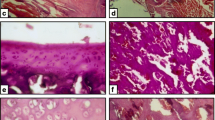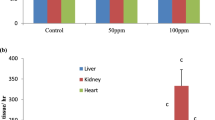Abstract
Pineal glands secrets melatonin and various proteins and peptides which has many physiological functions. In keeping with this view, present experiment was conducted to know the effect of buffalo (Bubalus bubalis) pineal proteins (PP) at different dose level on fluoride-induced changes in plasma biochemicals and blood antioxidants enzymes in female rats. For this, we took 30 adult female Wistar rats (133–145 g body weights, BW) and divided into five groups (control, group I; 150 ppm fluoride (F), group II; F+ 50 µg pineal proteins, group III; F+ 100 µg PP, group IV; F+ 200 µg PP, group V). We administered fluoride (150 ppm, drinking water) and F+ pineal proteins at 50, 100, and 200 µg/kg BW, i.p. daily for 21 days. Blood samples were collected at the end of the experiments to estimate plasma glucose, proteins, F, lipid peroxidation (LPO), alkaline phosphatase (ALP), and acetyl cholinesterase (AChE) activity. Red blood cells (RBCs) were separated for analysis of LPO, AChE, catalase (CAT), superoxide dismutase (SOD), reduced glutathione (GSH), glutathione peroxidase (GPx), and glutathione reductase (GR) in different groups of animals. Total plasma glucose and protein level did not significantly change in F-treated rats. Plasma ALP and F level were significantly (p < 0.05) high in group II as compared with control and groups III, IV, and V. Administration of PP at different dose level significantly (p < 0.05) reduced the F concentration and ALP activity. Plasma and RBCs AChE activity was significantly (p < 0.05) reduced in F-treated animals as compared with control rats and significantly (p < 0.05) elevated on exogenous administration of PP (groups III and IV). Plasma and RBCs LPO level was significantly (p < 0.05) high in F-alone-treated rats, and PP caused significant (p < 0.05) reduction of LPO in groups IV and V. However, PP treatment in group IV brought better amelioration of F-induced high LPO than in groups III and V. At no dose level, PP-ameliorated F-induced depression of RBCs GSH, CAT, GR, and GPx level. Interestingly, SOD activity was elevated in dose-dependent manner at different dose level of PP in groups III, IV, and V than control and F-administered rats. These findings clearly indicate the beneficial effects of buffalo pineal proteins on fluoride-induced adverse changes in certain plasma biochemical and blood antioxidant systems of rats. It further indicates that PP has dose-dependent ameliorative function against F-induced adverse effects in plasma and blood.
Similar content being viewed by others
References
Chinoy NJ (1994) Effects of fluoride on physiology of animals and haematology. Indian J Environ Toxicol 1:17–32
Shivarajashankara YM, Shivashankara AR, Bhat PG, Rao SH (2001) Effect of fluoride intoxication on lipid peroxidation and antioxidant systems in rats. Fluoride 34:108–113
Mittal M, Flora SJS (2006) Effects of individual and combined exposure to sodium arsenite and sodium fluoride on tissue oxidative stress, arsenic and fluoride levels in male mice. Chem Biol Interact 162:128–139
Georgieva NV (2005) Oxidative stress as a factor of disrupted ecological oxidative balance in biological systems—a review. Bulgarian J Vet Med 8:1–11
Reiter RJ, Melchiorri D, Sewerynek E, Poeggler B (1995) A review of the evidence supporting melatonin’s role as an antioxidant. J Pineal Res 23:43–50
Deneke SM, Baxter DF, Phelps DT, Fanburg BL (1989) Increase in endothelial cell glutathione and precursor amino acid uptake by ethyl maleate and hypoxia. Am J Physiol 275:265–271
Tandon M, Srivastava RS, Meur SK, Saini M (2006) Proteins and peptides present in pineal gland and other brain structures of buffaloes. Indian J Anim Sci 76:383–394
Ramasamy M (2006) Studies on bubaline pineal proteins/peptides below 20 kDa and their immunopotentiation in guinea pigs. Ph.D. Thesis. Indian Veterinary Research Institute, Izatnagar, India, 2006.
Bharti VK, Srivastava RS (2009) Pineal proteins up-regulate specific antioxidant defense systems in the brain. Oxid Med Cell Longev 2:88–92
Bharti VK (2008) Studies on buffalo (Bubalus bubalis) pineal proteins on fluoride-induced oxidative stress and apoptosis in rats. Ph.D. Thesis. Indian Veterinary Research Institute, Izatnagar, India, 2008.
Bharti VK, Srivastava RS (2009) Protective role of buffalo pineal proteins on arsenic-induced oxidative stress in blood and kidney of rats. Health 1:167–172
Ellman GE, Courtney KD, Andersen V Jr (1961) Featherstone of acetylcholine esterase activity. Biochem Pharmacol 7:88–95
Rehman S (1984) Lead-induced regional lipid peroxidation in brain. Toxicol Lett 21:333–337
Prins HK, Loos JA (1969) Glutathione. In: Yunis JJ (ed) Biochemical methods in red cell genetics. Academic Press, New York, pp 127–129
Bergmayer HU (1983) UV method of catalase assay. In: Methods of Enzymatic Analysis. VCH Verlag, Weinheim Deerfield Beach, Florida, p 273
Madesh M, Balasubramanian KA (1998) Microtitre plate assay for superoxide dismutase using MTT reduction by superoxide. Indian J Biochem Biophys 35:184–188
Paglia DE, Valentine WN (1967) Studies on the quantitative and qualitative characterization of erythrocyte glutathione peroxidase. J Lab Clin Med 70:158–169
Goldberg DM, Spooner RJ (1983) Glutathione reductase. In: Grassi M, Bergmeyer J (eds) Methods in enzymatic analysis. VCH Weinheim, Germany, pp 258–265
Bharti VK, Gupta M, Lall D, Kapoor V (2007) Effects of boron on haemogram and biochemical profile of urine in buffalo calves fed a high fluoride ration. Fluoride 40:238–243
Singh JL, Swarup D (1994) Fluorosis in buffaloes. Vet Res 135:260
Krook L, Minor RR (1998) Fluoride and alkaline phosphatase. Fluoride 31:177–182
Shanthakumari D, Srinivasalu S, Subramanian S (2004) Effect of fluoride intoxication on lipid peroxidation and antioxidant status in experimental rats. Toxicology 204:219–228
Bharti VK, Srivastava RS (2009) Fluoride-induced oxidative stress in rat's brain and its amelioration by buffalo (Bubalus bubalis) pineal proteins and melatonin. Biol Trace Elem Res 130:131–140
Hawkes WC, Alkan Z (2010) Regulation of redox signaling by selenoproteins. Biol Trace Elem Res. doi:10.1007/s12011-010-8656-7
Nicotera P, Orrenius S (1989) Role of thiols in protection against biological reactive intermediates. Adv Exp Med Biol 197:41–49
Flora SJS (1999) Arsenic-induced oxidative stress and its reversibility following combined administration of N-acetylcysteine and meso 2, 3-dimercaptosuccinic acid in rats. Clin Exp Pharmacol Physiol 26:865–869
Bhadauria S, Flora SJS (2007) Response of arsenic-induced oxidative stress, DNA damage, and metal imbalance to combined administration of DMSA and monoisoamyl-DMSA during chronic arsenic poisoning in rats. Cell Biol Toxicol 23:91–104
Acknowledgements
Research grant in the shape of Institute Senior Research Fellowship to the first author and facilities provided by Indian Veterinary Research Institute for conducting this study is duly acknowledged. We also acknowledge the tireless efforts of our lab and animal shed assistants.
Author information
Authors and Affiliations
Corresponding author
Rights and permissions
About this article
Cite this article
Bharti, V.K., Srivastava, R.S. Effect of Pineal Proteins at Different Dose Level on Fluoride-Induced Changes in Plasma Biochemicals and Blood Antioxidants Enzymes in Rats. Biol Trace Elem Res 141, 275–282 (2011). https://doi.org/10.1007/s12011-010-8733-y
Received:
Accepted:
Published:
Issue Date:
DOI: https://doi.org/10.1007/s12011-010-8733-y




